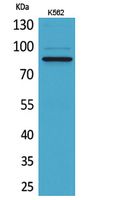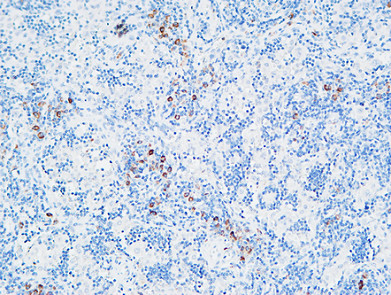MPO Polyclonal Antibody
- Catalog No.:YT5351
- Applications:WB;IHC;IF;ELISA
- Reactivity:Human;Mouse;Rat
- Target:
- MPO
- Fields:
- >>Drug metabolism - other enzymes;>>Phagosome;>>Neutrophil extracellular trap formation;>>Transcriptional misregulation in cancer;>>Acute myeloid leukemia
- Gene Name:
- MPO
- Protein Name:
- Myeloperoxidase
- Human Gene Id:
- 4353
- Human Swiss Prot No:
- P05164
- Mouse Gene Id:
- 17523
- Mouse Swiss Prot No:
- P11247
- Immunogen:
- The antiserum was produced against synthesized peptide derived from the N-terminal region of human MPO. AA range:41-90
- Specificity:
- MPO Polyclonal Antibody detects endogenous levels of MPO protein.
- Formulation:
- Liquid in PBS containing 50% glycerol, 0.5% BSA and 0.02% sodium azide.
- Source:
- Polyclonal, Rabbit,IgG
- Dilution:
- IHC: 100-300.WB 1:500 - 1:2000. ELISA: 1:20000.. IF 1:50-200
- Purification:
- The antibody was affinity-purified from rabbit antiserum by affinity-chromatography using epitope-specific immunogen.
- Concentration:
- 1 mg/ml
- Storage Stability:
- -15°C to -25°C/1 year(Do not lower than -25°C)
- Other Name:
- MPO;Myeloperoxidase;MPO
- Observed Band(KD):
- 85kD
- Background:
- Myeloperoxidase (MPO) is a heme protein synthesized during myeloid differentiation that constitutes the major component of neutrophil azurophilic granules. Produced as a single chain precursor, myeloperoxidase is subsequently cleaved into a light and heavy chain. The mature myeloperoxidase is a tetramer composed of 2 light chains and 2 heavy chains. This enzyme produces hypohalous acids central to the microbicidal activity of neutrophils. [provided by RefSeq, Nov 2014],
- Function:
- catalytic activity:Cl(-) + H(2)O(2) = HOCl + 2 H(2)O.,catalytic activity:Donor + H(2)O(2) = oxidized donor + 2 H(2)O.,cofactor:Binds 1 calcium ion per heterodimer.,cofactor:Binds 1 heme B (iron-protoporphyrin IX) group covalently per heterodimer.,disease:Defects in MPO are the cause of myeloperoxidase deficiency (MPD) [MIM:254600]. MPD is an autosomal recessive defect that results in disseminated candidiasis.,function:Part of the host defense system of polymorphonuclear leukocytes. It is responsible for microbicidal activity against a wide range of organisms. In the stimulated PMN, MPO catalyzes the production of hypohalous acids, primarily hypochlorous acid in physiologic situations, and other toxic intermediates that greatly enhance PMN microbicidal activity.,online information:MPO mutation db,online information:Myeloperoxidase entry,similarity:Belongs to the peroxidase family. XPO sub
- Subcellular Location:
- Lysosome.
- Expression:
- Leukemia,Leukocyte,Liver,Plasma,Saliva,
Adropin attenuates pancreatitis‑associated lung injury through PPARγ phosphorylation‑related macrophage polarization. INTERNATIONAL JOURNAL OF MOLECULAR MEDICINE Shangeng Weng IHC Mouse 1:200 lung tissue
USP11 exacerbates radiation induced pneumonitis by activating endothelial cell inflammatory response via OTUD5-STING signaling INTERNATIONAL JOURNAL OF RADIATION ONCOLOGY BIOLOGY PHYSICS Yiting Tang IHC Mouse 1:200 pulmonary tissue
The lipid-metabolism enzyme ECI2 reduces neutrophil extracellular traps formation for colorectal cancer suppression Nature Communications Chen Lixia IF Mouse MC38 cell-Xenograft,liver tissue dHL-60 cell,HCT116 cell,RKO cell,MC38 cell
- June 19-2018
- WESTERN IMMUNOBLOTTING PROTOCOL
- June 19-2018
- IMMUNOHISTOCHEMISTRY-PARAFFIN PROTOCOL
- June 19-2018
- IMMUNOFLUORESCENCE PROTOCOL
- September 08-2020
- FLOW-CYTOMEYRT-PROTOCOL
- May 20-2022
- Cell-Based ELISA│解您多样本WB检测之困扰
- July 13-2018
- CELL-BASED-ELISA-PROTOCOL-FOR-ACETYL-PROTEIN
- July 13-2018
- CELL-BASED-ELISA-PROTOCOL-FOR-PHOSPHO-PROTEIN
- July 13-2018
- Antibody-FAQs
- Products Images

- Adropin attenuates pancreatitis‑associated lung injury through PPARγ phosphorylation‑related macrophage polarization. INTERNATIONAL JOURNAL OF MOLECULAR MEDICINE Shangeng Weng WB Mouse 1:1000 lung tissue

- Western Blot analysis of K562 cells using MPO Polyclonal Antibody. Secondary antibody(catalog#:RS0002) was diluted at 1:20000

- Immunohistochemical analysis of paraffin-embedded Human lung. 1, Antibody was diluted at 1:100(4° overnight). 2, High-pressure and temperature EDTA, pH8.0 was used for antigen retrieval. 3,Secondary antibody was diluted at 1:200(room temperature, 30min).

- Immunohistochemical analysis of paraffin-embedded Human lymphoma. 1, Antibody was diluted at 1:100(4° overnight). 2, High-pressure and temperature EDTA, pH8.0 was used for antigen retrieval. 3,Secondary antibody was diluted at 1:200(room temperature, 30min).



